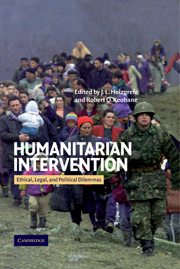Book contents
- Frontmatter
- Contents
- List of contributions
- Acknowledgments
- Introduction
- PART I The context for humanitarian intervention
- 1 The humanitarian intervention debate
- 2 Humanitarian intervention before and after 9/11: legality and legitimacy
- PART II The ethics of humanitarian intervention
- PART III Law and humanitarian intervention
- PART IV The politics of humanitarian intervention
- Select English language bibliography
- Index
1 - The humanitarian intervention debate
Published online by Cambridge University Press: 27 July 2009
- Frontmatter
- Contents
- List of contributions
- Acknowledgments
- Introduction
- PART I The context for humanitarian intervention
- 1 The humanitarian intervention debate
- 2 Humanitarian intervention before and after 9/11: legality and legitimacy
- PART II The ethics of humanitarian intervention
- PART III Law and humanitarian intervention
- PART IV The politics of humanitarian intervention
- Select English language bibliography
- Index
Summary
On 6 April 1994, President Habyarimana of Rwanda and several top government officials were killed when their plane was shot down by a surface-to-air missile on its approach to Kigali airport. Within hours, members of the Hutu-dominated government, presidential guard, police, and military started rounding up and executing opposition politicians. The army set up roadblocks at 50 to 100 meter intervals throughout Kigali. The airport was surrounded and sealed. Telephone lines were cut. Military intelligence distributed lists of the government's political opponents to death squads: “every journalist, every lawyer, every professor, every teacher, every civil servant, every priest, every doctor, every clerk, every student, every civil rights activist were hunted down in a house-to-house operation. The first targets were members of the never-to-be-constituted broad-based transitional government.”
Once the Tutsi leadership and intelligentsia were killed, the army, presidential guard, and the Interahamwe militia, the youth wing of the ruling Hutu party, began executing anyone whose identity cards identified them as Tutsis. When checking identity cards became too time-consuming, they executed anyone with stereotypical Tutsi features. On 9 April, the Interahamwe militia directed by presidential guards hacked to death 500 men, women, and children who had taken shelter in the Catholic mission in Kigali. In another incident, the Interahamwe shot 120 men and boys who had taken refuge in St. Famille Church in Kigali. Soldiers killed any wounded Tutsis who made it to hospital. One killer went so far as to thank hospital staff for providing a “Tutsi collection point.”
- Type
- Chapter
- Information
- Humanitarian InterventionEthical, Legal and Political Dilemmas, pp. 15 - 52Publisher: Cambridge University PressPrint publication year: 2003
- 65
- Cited by



